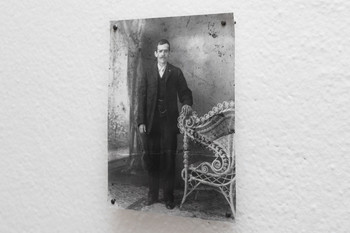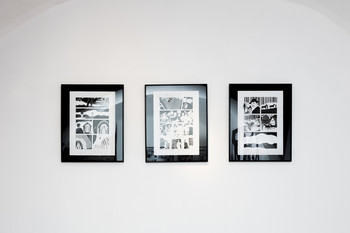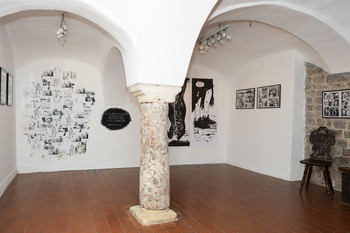Martin Ramoveš: The Cat's Head
Ivan Grohar Gallery
24 July– 8 Sept 2024
Curator: Maša Žekš
The Ivan Grohar Gallery in Škofja Loka presents a solo exhibition by Martin Ramoveš, last year’s winner of the Ivan Grohar Creativity Scholarship. The cornerstone of Ramoveš’s creativity is poetry, which he translates into his own distinctive comic narrative and music. His comic albums are characterised by an expressive black-and-white style, which he uses to depict gloomy stories, paired with fiction and (un)popular references to the history of the Slovenian countryside. The exhibition titled The Cat’s Head features his latest comic works, based on stories by Janez Ramoveš, which, referring to various historical facts, testify to the tragic motives behind local smuggling and the emigration of the Slovenian people to the United States as the promised land.
The Cat’s Head serves as a temporal prism with the semi-past memories and tragic content of the artist’s most recent comics, Smugglers/Kontrabantarji (2021) and America/Amerika (2023), seeping through it. Unlike his older works, most of which were musical-comic albums and used the artist’s own music as the basis for the literary work, the two comics in question boast a well-thought-out emphasis on raw hand-drawing and an evolving poetics of form. The semi-fictional historical stories are marked by the artist’s characteristic realism, perfectly graded sequences and visual contrast. As part of this exhibition, they are enhanced from their original medium to a multi-media ambient installation. In addition to focusing on the presentation of comic book production and the materiality of sketches, photocopies, notes and photographs, The Cat’s Head, with its semi-museum-like exhibition display and direct rawness, embodies the atmosphere of the local environment at the turn of the last century, marked by poverty, Catholicism, violence, sexism, envy, alcoholism and death.
The title of the exhibition corresponds to one of the most important entities of the Smugglers/Kontrabantarji comic – the village inn, where bustling card gambling, folk songs, boozing and petty “fuckery” are accompanied by conspiracies, mutual deceit and anger. The tragic story of the desperate Matija is just one of the many past stories that happened to our ancestors – in moments of possible folly or excitement – who, in search of a better life, money and assets in the form of mistresses who ran away with others, proud children or land, entered into the fatal smuggling deals across the Rapallo border. The same goes for the innocent “brood of bastards” whose parents moved to the United States by force of circumstances, died too soon or made decisions that were considered a sin by society and the Church. The utterly convincing and to a large extent true stories illustrate a struggle for survival marked by anxiety and constant failure. The tense atmosphere and the sense of uncertainty in the depictions are built up by a meaningful sequence of details and a simple reduced text, which often refers to selected quotes from Slovenian literature and film or to existing contemporary poetry. The sequences of images, which at times appear like skilfully framed film direction, include details of the pig slaughter, an accordion, a crucifix, a depiction of the famed Slovenian writer Ivan Tavčar, a border map, a boundary marker on the Krn moss, hunting trophies, a solitary hayrack, milking, dinars, grave candles and a wasp nest found at the side of a wayside shrine. The unbridled realism of the drawing and the allowed imperfections are combined with continuous tragedy, poverty, night-time scenes, gloomy dialogue, rustic sets and action to form a genre that in Smugglers/Kontrabantarji resembles a mentally unstable manic western, while in America/Amerika it borders on a vengeful family drama that turns into a dead-end horror film.
Both comics are characterised by fast-paced action with in-between pauses, where idyllic depictions of the Slovenian countryside stand out. Music also has a special place; it is depicted through musical instruments, poetry, sung pub songs and litanies. In addition to the visual chiaroscuro and expressiveness, the contrast also appears in the relationship between the secular content (revelry at the inn, farm work, politics and sexuality) and hagiological subjects (the order of Mass, the nuclear family, conservative values, wayside shrines), and in the America comic, it also shows the profound difference between the humble, religious rural periphery on the one hand, and the debauched, urban, capitalist jungle on the other. This contrast and drama is reflected in a varied exhibition display, as part of which visitors can read the individual comics in peace and quiet, while also enjoying a physical presentation of the artist’s working process. As part of a series of comic tales about the Poljane Valley, the exhibition features photographs relevant to the time and place, as well as the first rudiments of Ramoveš’s next comic titled Wild Chase/Divja jaga. The exhibition, which is conceived as a broader presentation of Martin Ramoveš’s interdisciplinary production, including the literary works authored by his father Janez Ramoveš, addresses the visitors’ contemporaneity with a seemingly nostalgic ambience, permeated by the specific characteristics of the zeitgeist, memories of the war, thematic discomfort, Catholic guilt, music, genre and fiction. In fact, Smugglers/Kontrabantarji begins much like a haunting Tarantino spectacle, while the derivative of America/Amerika offers the subversion of a zombie show, which subverts the criticism of capitalism to the tragic consequences of the harsh reality of farm life.
Curator: Maša Žekš
Martin Ramoveš
Martin Ramoveš (1989) is a comic book author, singer-songwriter and educator. The debut music album The Sound of the Country/Zvok dežele by his musical ensemble, Martin Ramoveš Band, was released in 2012, and was followed by three comic-musical albums: The Never-to-Be Cowboys/Nesojeni kavboji (2014), Astronomers/Astronomi (2017) and Rob – The Taunting Poet in Comics and Music/Rob – zbadljivi poet v stripu in glasbi (2019). In collaboration with the poet Janez Ramoveš, he created a series of comic albums, of which two have been published so far: Smugglers/Kontrabantarji (2021) and America/Amerika (2023). Since 2021, his series of comics titled Loud Comics/Glasni stripi has been published in the Glasna magazine. Ramoveš has authored numerous short comics, which have been featured in the Stripburger magazine, as well as in didactic literature, such as the string orchestra textbook titled The Genius That Was Ludwig van Beethoven/Genialni Ludwig van Beethoven. As a drawing artist, he has co-authored the animations for the LP film A Bulldozer – Spit the Truth in Its Eyes/Buldožer – Pljuni istini u oči and illustrated several books, most recently the English edition of Gregor Strniša’s collection of poems Outer Space/ Vesolje. Tina Mohorović presented the drawings based on his poems in the book titled Calm – Drawn Songs/Brezvetrje – Narisane pesmi. Since 2020, he has been a member of the Škofja Loka Artists’ Association, which awarded him the Ivan Grohar Creativity Scholarship in 2023.
Accompanying programme
- A guided tour of the exhibition with the curator and artist: Wednesday, 28 August 2024, at 18:00.






























